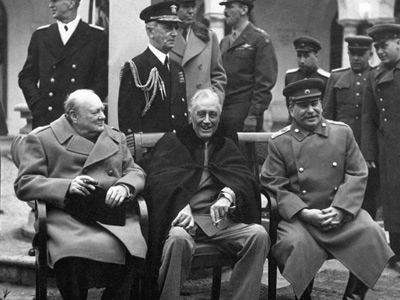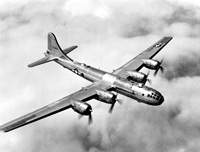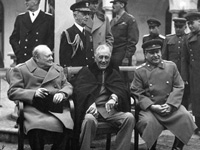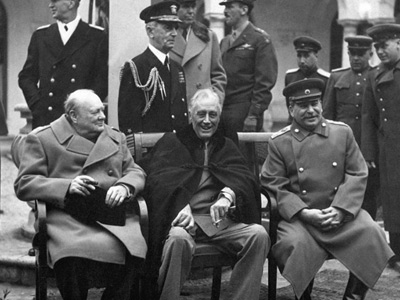Cold War (1947–1991)

The Cold War was a state of geopolitical tension after World War II between powers in the Eastern Bloc (the Soviet Union and its satellite states) and powers in the Western Bloc (the United States, its NATO allies and others). Historians do not fully agree on the dates, but a common timeframe is the period between 1947, the year the Truman Doctrine, a U.S. foreign policy pledging to aid nations threatened by Soviet expansionism, was announced, and either 1989, when communism fell in Eastern Europe, or 1991, when the Soviet Union Soviet Union, officially the Union of Soviet Socialist Republics (USSR), was a transcontinental country that spanned much of Eurasia from 1922 to 1991. The Soviet Union fall process began with growing unrest in the Union's various constituent national republics developing into an incessant political and legislative conflict between them and the central government. Estonia was the first Soviet republic to declare state sovereignty inside the Union. collapsed. The term "cold" is used because there was no large-scale fighting directly between the two sides, but they each supported major regional wars known as proxy wars.
Soviet Union, officially the Union of Soviet Socialist Republics (USSR), was a transcontinental country that spanned much of Eurasia from 1922 to 1991. The Soviet Union fall process began with growing unrest in the Union's various constituent national republics developing into an incessant political and legislative conflict between them and the central government. Estonia was the first Soviet republic to declare state sovereignty inside the Union. collapsed. The term "cold" is used because there was no large-scale fighting directly between the two sides, but they each supported major regional wars known as proxy wars.
The Cold War split the temporary wartime alliance against Nazi Germany, leaving the Soviet Union and the United States The United States of America (U.S.A. or USA), commonly known as the United States (U.S. or US) or America, is a country in North America. It is the world's third-largest country by both land and total area. The United States shares land borders with Canada to its north and with Mexico to its south. The national capital is Washington, D.C., and the most populous city and financial center is New York City. as two superpowers with profound economic and political differences. The USSR was a Marxist–Leninist state led by its Communist Party, which in turn was dominated by a leader with different titles over time, and a small committee called the Politburo. The Party controlled the press, the military, the economy and many organizations. It also controlled the other states in the Eastern Bloc, and funded Communist parties around the world, sometimes in competition with Communist China, particularly following the Sino-Soviet split of the 1960s. In opposition stood the capitalist West, led by the United States, a federal republic with a two-party presidential system. The First World nations of the Western Bloc were generally liberal democratic with a free press and independent organizations, but were economically and politically entwined with a network of banana republics and other authoritarian regimes throughout the Third World, most of which were the Western Bloc's former colonies. Some major Cold War frontlines such as Vietnam, Indonesia, and the Congo were still Western colonies in 1947.
The United States of America (U.S.A. or USA), commonly known as the United States (U.S. or US) or America, is a country in North America. It is the world's third-largest country by both land and total area. The United States shares land borders with Canada to its north and with Mexico to its south. The national capital is Washington, D.C., and the most populous city and financial center is New York City. as two superpowers with profound economic and political differences. The USSR was a Marxist–Leninist state led by its Communist Party, which in turn was dominated by a leader with different titles over time, and a small committee called the Politburo. The Party controlled the press, the military, the economy and many organizations. It also controlled the other states in the Eastern Bloc, and funded Communist parties around the world, sometimes in competition with Communist China, particularly following the Sino-Soviet split of the 1960s. In opposition stood the capitalist West, led by the United States, a federal republic with a two-party presidential system. The First World nations of the Western Bloc were generally liberal democratic with a free press and independent organizations, but were economically and politically entwined with a network of banana republics and other authoritarian regimes throughout the Third World, most of which were the Western Bloc's former colonies. Some major Cold War frontlines such as Vietnam, Indonesia, and the Congo were still Western colonies in 1947.
A small neutral bloc arose with the Non-Aligned Movement; it sought good relations with both sides. The two superpowers never engaged directly in full-scale armed combat, but they were heavily armed in preparation for a possible all-out nuclear world war. Each side had a nuclear strategy that discouraged an attack by the other side, on the basis that such an attack would lead to the total destruction of the attacker—the doctrine of mutually assured destruction (MAD). Aside from the development of the two sides' nuclear arsenals, and their deployment of conventional military forces, the struggle for dominance was expressed via proxy wars around the globe, psychological warfare, massive propaganda campaigns and espionage, rivalry at sports events, and technological competitions such as the Space Race.
The first phase of the Cold War began in the first two years after the end of the Second World War World War II or the Second World War, often abbreviated as WWII or WW2, was a world war that lasted from 1939 to 1945. It involved the vast majority of the world's countries—including all of the great powers—forming two opposing military alliances: the Allies and the Axis powers. World War II was a total war that directly involved more than 100 million personnel from more than 30 countries. World War II is generally considered to have begun on 1 September 1939, when Nazi Germany, under Adolf Hitler, invaded Poland. View World War II » in 1945. The USSR consolidated its control over the states of the Eastern Bloc, while the United States began a strategy of global containment to challenge Soviet power, extending military and financial aid to the countries of Western Europe (for example, supporting the anti-communist side in the Greek Civil War) and creating the NATO alliance. The Berlin Blockade (1948–49) was the first major crisis of the Cold War. With the victory of the communist side in the Chinese Civil War and the outbreak of the Korean War (1950–53), the conflict expanded. The USSR and the USA competed for influence in Latin America and the decolonizing states of Africa and Asia. Meanwhile, the Hungarian Revolution of 1956 was stopped by the Soviets. The expansion and escalation sparked more crises, such as the Suez Crisis (1956), the Berlin Crisis of 1961, and the Cuban Missile Crisis of 1962. Following the Cuban Missile Crisis, a new phase began that saw the Sino-Soviet split complicate relations within the communist sphere, while US allies, particularly France
World War II or the Second World War, often abbreviated as WWII or WW2, was a world war that lasted from 1939 to 1945. It involved the vast majority of the world's countries—including all of the great powers—forming two opposing military alliances: the Allies and the Axis powers. World War II was a total war that directly involved more than 100 million personnel from more than 30 countries. World War II is generally considered to have begun on 1 September 1939, when Nazi Germany, under Adolf Hitler, invaded Poland. View World War II » in 1945. The USSR consolidated its control over the states of the Eastern Bloc, while the United States began a strategy of global containment to challenge Soviet power, extending military and financial aid to the countries of Western Europe (for example, supporting the anti-communist side in the Greek Civil War) and creating the NATO alliance. The Berlin Blockade (1948–49) was the first major crisis of the Cold War. With the victory of the communist side in the Chinese Civil War and the outbreak of the Korean War (1950–53), the conflict expanded. The USSR and the USA competed for influence in Latin America and the decolonizing states of Africa and Asia. Meanwhile, the Hungarian Revolution of 1956 was stopped by the Soviets. The expansion and escalation sparked more crises, such as the Suez Crisis (1956), the Berlin Crisis of 1961, and the Cuban Missile Crisis of 1962. Following the Cuban Missile Crisis, a new phase began that saw the Sino-Soviet split complicate relations within the communist sphere, while US allies, particularly France France, officially the French Republic is transcontinental country predominantly located in Western Europe and spanning overseas regions and territories in the Americas and the Atlantic, Pacific and Indian Oceans. France reached its political and military zenith in the early 19th century under Napoleon Bonaparte, subjugating much of continental Europe and establishing the First French Empire. , demonstrated greater independence of action. The USSR crushed the 1968 Prague Spring liberalization program in Czechoslovakia, and the Vietnam War (1955–75) ended with the defeat of the US-backed Republic of Vietnam, prompting further adjustments.
France, officially the French Republic is transcontinental country predominantly located in Western Europe and spanning overseas regions and territories in the Americas and the Atlantic, Pacific and Indian Oceans. France reached its political and military zenith in the early 19th century under Napoleon Bonaparte, subjugating much of continental Europe and establishing the First French Empire. , demonstrated greater independence of action. The USSR crushed the 1968 Prague Spring liberalization program in Czechoslovakia, and the Vietnam War (1955–75) ended with the defeat of the US-backed Republic of Vietnam, prompting further adjustments.
By the 1970s, both sides had become interested in making allowances in order to create a more stable and predictable international system, ushering in a period of détente that saw Strategic Arms Limitation Talks and the US opening relations with the People's Republic of China as a strategic counterweight to the Soviet Union. Détente collapsed at the end of the decade with the beginning of the Soviet–Afghan War in 1979. The early 1980s were another period of elevated tension, with the Soviet downing of Korean Air Lines Flight 007 (1983), and the "Able Archer" NATO military exercises (1983). The United States increased diplomatic, military, and economic pressures on the Soviet Union, at a time when the communist state was already suffering from economic stagnation. In the mid-1980s, the new Soviet leader Mikhail Gorbachev introduced the liberalizing reforms of perestroika ("reorganization", 1987) and glasnost ("openness", c. 1985) and ended Soviet involvement in Afghanistan. Pressures for national independence grew stronger in Eastern Europe, especially Poland Poland, officially the Republic of Poland, and in historical context referred to as the Third Polish Republic, is a country in Central Europe. The Kingdom of Poland emerged in 1025 and in 1569 cemented its longstanding association with Lithuania, thus forming the Polish–Lithuanian Commonwealth. It was one of the largest great powers of Europe at the time, with a uniquely liberal political system that adopted Europe's first modern constitution in 1791.. Gorbachev meanwhile refused to use Soviet troops to bolster the faltering Warsaw Pact regimes as had occurred in the past. The result in 1989 was a wave of revolutions that peacefully (with the exception of the Romanian Revolution) overthrew all of the communist regimes of Central and Eastern Europe. The Communist Party of the Soviet Union itself lost control and was banned following an abortive coup attempt in August 1991. This in turn led to the formal dissolution of the USSR in December 1991 and the collapse of communist regimes in other countries such as Mongolia, Cambodia and South Yemen. The United States remained as the world's only superpower.
Poland, officially the Republic of Poland, and in historical context referred to as the Third Polish Republic, is a country in Central Europe. The Kingdom of Poland emerged in 1025 and in 1569 cemented its longstanding association with Lithuania, thus forming the Polish–Lithuanian Commonwealth. It was one of the largest great powers of Europe at the time, with a uniquely liberal political system that adopted Europe's first modern constitution in 1791.. Gorbachev meanwhile refused to use Soviet troops to bolster the faltering Warsaw Pact regimes as had occurred in the past. The result in 1989 was a wave of revolutions that peacefully (with the exception of the Romanian Revolution) overthrew all of the communist regimes of Central and Eastern Europe. The Communist Party of the Soviet Union itself lost control and was banned following an abortive coup attempt in August 1991. This in turn led to the formal dissolution of the USSR in December 1991 and the collapse of communist regimes in other countries such as Mongolia, Cambodia and South Yemen. The United States remained as the world's only superpower.
The Cold War and its events have left a significant legacy. It is often referred to in popular culture, especially in media featuring themes of espionage (notably the internationally successful James Bond film franchise) and the threat of nuclear warfare.
HISTORY

RESOURCES
This article uses material from the Wikipedia article "Cold War (1947–1991)", which is released under the Creative Commons Attribution-Share-Alike License 3.0.
© Stories Preschool. All Rights Reserved.









